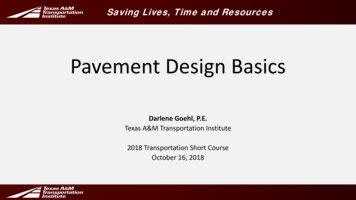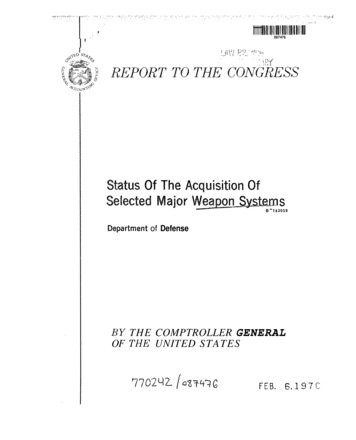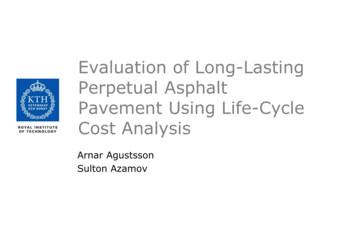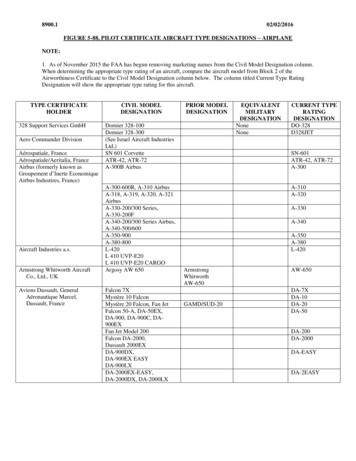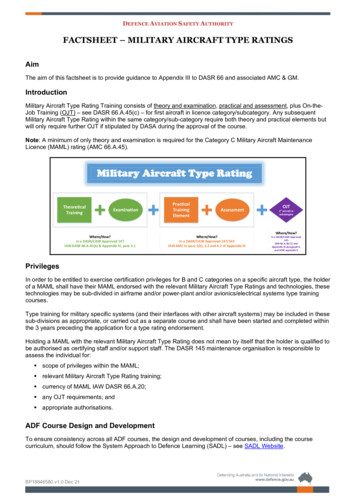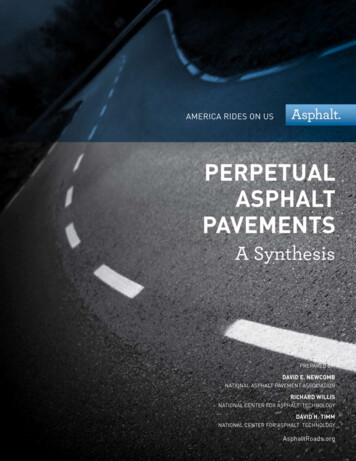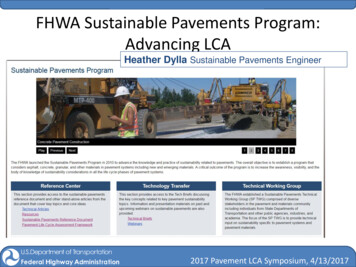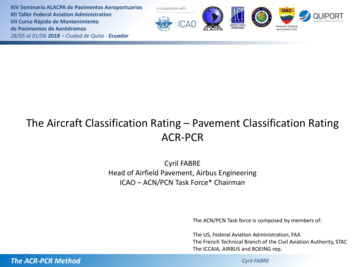
Transcription
XIV Seminario ALACPA de Pavimentos AeroportuariosXII Taller Federal Aviation AdministrationVII Curso Rápido de Mantenimientode Pavimentos de Aeródromos28/05 al 01/06 2018 – Ciudad de Quito - EcuadorThe Aircraft Classification Rating – Pavement Classification RatingACR-PCRCyril FABREHead of Airfield Pavement, Airbus EngineeringICAO – ACN/PCN Task Force* ChairmanThe ACN/PCN Task force is composed by members of:The US, Federal Aviation Administration, FAAThe French Technical Branch of the Civil Aviation Authority, STACThe ICCAIA, AIRBUS and BOEING rep.1The ACR-PCR MethodCyril FABRE
Why a renewed ACN/PCN method? Currently, there is an inconsistency between the ACN/PCN system and the recent pavement design methodsFor the above reasons, the current ACN/PCN system is deemed outdated as it fails to take into account accurately:– An accurate correlation between the pavement design practice and the rating system– The effect of modern and/or complex landing gear configurations (multi-wheel arrangement)– The improved mechanical characteristics of new-generation materialsHence, the urgent need to align the ACN/PCN system with the LEA pavement design methods The ACR-PCRNote: The LEA was already envisaged in the ADM Part 3, in 1983, but the lack of IT technologies solutions postponedits use.Type of methodACN/PCN system(aircraft admissibility evaluation)Pavement design methodsBased on the « CBR design procedure » sincethe system’s entry into service in 1983Gradually moving to « rational » methods based onthe Linear Elastic Analysis (LEA*)InconsistenciesSystem’s rationaleEmpirical method that does not consider theactual mechanical response of the pavementMechnanistic-empirical method that considers thepavement mechanical (stress-strain) response toaircraft loads as well as the pavement performanceConsideration ofmulti-wheelslanding gearsEquivalencies to single wheels(ESWL, alpha factors)All wheels considered explicitly for the pavementresponse computationConsideration ofpavement materialcharacteristicsEquivalencies to a standard materialPavement material characteristics consideredexplicitly for the pavement response computation (Emodulus & Poisson’s ratio)
Benefits & Advantages of the renewed ACN/PCN method(ACR-PCR) The renewed ACR/PCR method overcomes the identified limitations of the current system and allows afull consideration of the latest evolutions in the field. It removes the need of existing equivalency factors or alpha-factors, whose definition might becontroversial The method will provide several benefits to airport owners:– Optimized usage of their pavements– Consistency between pavement design and aircraft admissibility parameters– Availability of generic PCR computation procedure– Improved predictability of pavement life– Unified soil characterization method for both flexible and rigid pavements This will also benefit the airlines and ultimately the whole air transportation community by allowingoptimized operating weights and frequencies, as opposed to the current over-conservative CBR-basedsystem The new method could be used by Airport to support pavement management system and subsequentregime of inspection and maintenance
Which Changes? By retaining the same appearance and simplicity of the current system, the changes would not be assubstantial as they might otherwise appear to those who are unfamiliar with airfield pavement. Theplain comparison of two numbers will then continue to be the core principle of the system Only the way of determining the two components (ACR calculation method and PCR procedure) will bemodified by permanently replacing the CBR design procedure by the LEA as the core of the newACR/PCR system. By adopting the LEA for both Flexible and Rigid pavements, the modulus of subgrade reaction for Rigidpavement (k-value), and the CBR on top of subgrade for flexible pavement will be replaced by a uniquesoil characterization method (Modulus of elasticity, E), and always declined into four categories (High,medium, low and ultra-low). The LEA will permit knowing the contribution of each aircraft composing a mix to the max. damageproduced by the total traffic, through the “Cumulative Damage Factor (CDF)” concept. This will ease thepavement overload criteria taking full advantage of how the overload aircraft behaves when it is mixedin an existing traffic mix. The Current software ICAO-ACN w1.0 will be replaced by ICAO-ACR 1.0 (already developed) to computeevery aircraft ACRs at any weight and center of gravity position.
In a Nutshell The new ACR still relates to a DSWL but its calculation is done through the LEA for both Flexible andRigid PavementThe new PCR procedure consist in determining one or several critical aircraft within a mix and makes this(or those) aircraft equivalent to the mix by:1. Adjusting their actual number of annual departure so their max CDF equals the critical CDF of the mixat the critical offset (equivalent annual departure)2. Adjusting critical(s) aircraft operating weight to obtain a CDF of 1.0 for the number of equivalentannual departure3. Computing the aircraft ACR(s) at that weight. The ACR(s) so obtained is equal to the PCR(s)4. The PCR is the max of the PCR(s) obtained above The PCR of a pavement should reflect the pavement design requirements (the traffic mix for which thepavement was designed). If the critical CDF of a pavement is equal to or lower than 1.0, no aircraft weight restriction shouldoccurred If thecritical CDF of a pavement is greater than 1.0, weight restrictions should apply to at least one5aircraft composing the mix
AIRCRAFT CLASSIFICATION RATING (ACR) ACR. A number expressing the relative effect of an aircraft on a pavement for aspecified standard subgrade strength. Numerically defined as two times the derived single wheel load, where the derivedsingle wheel load is expressed in hundreds of kilograms. The single wheel tirepressure is standardized at 1.50 MPa. LEA is used for both Flexible and Rigid Pavement Standard Subgrade Strength Categories (Flex. & Rig. Commonality):CAT. ACAT. BCAT. CCAT. D200 MPa120 MPa80 MPa50 MPa
AIRCRAFT CLASSIFICATION RATING (ACR) – DSWL (Rigid)Wheel load adjustmentat P 1.5 MPaStandard working stress for reporting, 2.75 MPaDESIGN LAYERDSWL Workingstress 2.75MPa / t1E1 27 579 MPa, ν1 0.15 / Thickness adjustment t12.75 MPaE1 27 579 MPa, ν1 0.15 / t1E2 500 MPa, ν2 0.20 / t 200mmE2 500 MPa, ν2 0.20 / t 200mmA, B, C & D / Infinite depthA, B, C & D / Infinite depthThe aircraft classification rating, at the selected mass and subgrade category, is twice thederived single wheel load in 100 kg.
AIRCRAFT CLASSIFICATION RATING (ACR) – DSWL (Flexible)Aircraft MLG with 2 wheels or lessAircraft MLG with more than 2 wheelsReference structuresSubgrade categories& moduliACN computationprocedureCAT ACAT BCAT CCAT DE 200 MPaE 120 MPaE 80 MPaE 50 MPaStep 1: Design the pavement structure for below parameters:o 36,500 cumulated aircraft passeso No lateral wander (𝜎 0)o Design criterion: subgrade failureo Failure model: FAARFIELD v 1.41 failure model (Bleasdale Wöhler)o Multi-peak damage integration for multi-axle loadingStep 2: Compute the Derived Single Wheel Load (DSWL) that will produce the same CDF(1.00) on the previously designed pavement structure. The DSWL is computed with aconstant tire pressure of 1.5 MPa.Step 3: The Aircraft Classification Rating at the selected mass and subgrade category is givenby twice the DSWL (in hundred of Kgs) computed in step 2.
PAVEMENT CLASSIFICATION RATING (PCR)GENERAL PRINCIPLEFor a selected pavement and evaluated aircraft mix:– Determine the critical CDF (at the critical offset) Critical CDF 1, No weight limitation Critical CDF 1, Weight limitation for at least one aircraft in the mix– Determine the critical aircraft– Make the critical aircraft equivalent to the aircraft mix by adjusting its annualdeparture until it produces the same CDF as produced by the aircraft mix(equivalent annual departures)– Adjust the critical aircraft mass so that it produces a CDF of 1.0 for the number ofequivalent annual departure. This gives the Maximum Allowable Gross Weight(MAGW)– Compute the critical aircraft ACR at its MAGW– The reported PCR is the ACR of the critical aircraft at its MAGW
PAVEMENT CLASSIFICATION RATING (PCR) HOW TO DETERMINE THE CRITICAL AIRCRAFTGeneral case: The most contributing aircraft to the max CDF are the aircraft withthe highest ACR at their operating weight1.2.3.4. Test the most contributing aircraft to the critical CDF (AC1)and Run the procedure PCR1Remove the aircraft and test the first level reduction list – AC2 (the first critical aircraft isremoved and all other reintroduced PCR2Test the second level reduction list (AC3) PCR3PCR Max (PCR1, PCR2, PCR3)Specific case: Max aircraft ACRs are weight limited because of their small numberof annual departure while their contribution to the critical CDF is minor1.2.3.Run the procedure described above PCRRun the procedure for the max aircraft ACR PCR4If PCR4 PCR, then PCR PCR4 otherwise keep the PCR derived from the initial procedure
Overload Operationsa)For flexible and rigid pavements, occasional movements by aircraft with ACR notexceeding 10 per cent above the reported PCR should not adversely affect thepavement;b) The annual number of overload movements should not exceed approximately 5 percent of the total annual movements excluding light aircraft.c) Overloads in excess of 10% may be considered on a case by case basis whensupported by a more detailed technical analysis.When overload operations exceed allowances described above, a pavement analysis isrequired for granting the proposed additional loads which was not scheduled in theinitial pavement design. In those cases, the pavement analysis should determine howthe overload operation contributes to the maximum CDF when it is mixed with theactual traffic mix. Indeed, the ACR as a relative indicator, even if exceeding the reportedPCR cannot predict how the overload aircraft will affects the pavement structuralbehavior and/or its design life, since it will be strongly dependant of its offset to thelocation of the maximum CDF of the entire fleet (critical offset).
PCR EXAMPLEPAVEMENT CHARACTERISTICSE-Modulus (MPa)Poisson’s ratioLayersDesignationSurface courseP-401/P-403 HMASurface13790.3510.2P-401/P-403 (flex)27580.3512.7P2094230.3512.72000.35 Base courseSubbaseSubgradeThickness (cm)Pavement Cross Section#123456Aircraft 1-200TRAFFIC MIX ANALYSEDMax Taxi Weight (t)233.9352.457185.477.493.9Aircraft MixAnnual departure52525210950109501560
PCR EXAMPLE
PCR EXAMPLEA321-200(AC1)737900ER(AC2)777-300ER(Max 3.9571MAGW91.8584.25342NANANAEquivalentAnnual Ri@MAGW455369557NANANAPCRi455369557NANANARetained PCR Max (PCR1, PCR2, PCR3) 557 FAXTWeight limitations could apply to the 777-300ER, the A330-200 and marginally to the A380,but exceedance remains in the 10% allowance
PROCESS and TIMEFRAME New ACR-PCR System proposal submitted and adopted by the ICAO Aerodrome Design andOperation Panel (ADOP) in March 2018Next steps are:– Air Navigation Commission Review– ICAO Council Endorsement The ADOP suggested the following time frame:– Effectivity date: July 2020, i.e. The ACR-PCR system becomes the new ICAOPavement rating System; Training for users (CAAs, Airport, AC manufacturers)can be initiated, implementation phase stated– Applicability Date: November 2024, i.e AC manufacturer have published theirproduct ACRs in the relevant documentation (Airplane Characteristics forAirport Planning) and Airports have published their new PCRs in their AIPs
1. Test the most contributing aircraft to the critical CDF (AC1)and Run the procedure PCR1 2. Remove the aircraft and test the first level reduction list -AC2 (the first critical aircraft is removed and all other reintroduced PCR2 3. Test the second level reduction list (AC3) PCR3 4. PCR Max (PCR1, PCR2, PCR3)


